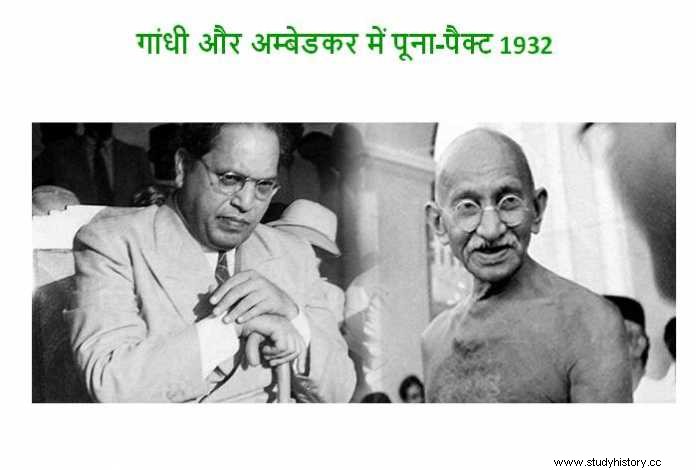
Poona-Pact between Gandhi and Ambedkar
Gandhiji strongly opposed the communal award, especially the provisions separating the Dalits from the Hindus and sat on a fast unto death on 20 September 1932. Dr. Ambedkar observed this fast as 'political cunning' Told. Some people called it a way to get their demand fulfilled.
When Gandhiji's health started deteriorating, the Congress leaders got an agreement done between Dr. Ambedkar and Gandhiji on 26 September 1932. This agreement is popularly known as Poona Pact. By this the objectionable part of the Communal Award was removed and Dr. Ambedkar was successful in securing twice the number of seats for the Dalits. Dr. Ambedkar had a dispute with both Gandhiji and Muhammad Ali Jinnah regarding the solution of India's problem.
That's why Ambedkar compared Gandhi and Jinnah and said that- 'Both these leaders should be separated from Indian politics.'
Domination of minorities over Hindus in Government of India Act 1935
After the announcement of the three Round Table Conferences of London and the Communal Arbitration, a new constitution was implemented in India. This is called the Government of India Act 1935. This constitution replaced the Government of India Act 1919. The main provisions of the new law were as follows-
(1) Burma will be separated from India.
(2) New provinces called Orissa and Sindh will be formed.
(3) An All India Union will be established in which the provinces and native states of British India will be included.
(4) The provinces will be given the right of self-government.
(5) The subjects of government shall be divided into three parts- (u) Union subjects, which shall be subject to the Centre. (ii) the provincial subjects, which shall be wholly subordinate to the provinces and (ii) the concurrent subjects, which shall be subject to the Center and the provinces. In case of opposition, the law of the Center will prevail.
(6) Under the federal constitution there will be two houses.
(7) The House of Assembly i.e. the lower house will have 375 seats, out of which the number of representatives of British-India will be 250 and the number of representatives of the native states will be 125.
(8) The election of 250 representatives of British-India in the Lower House will be done by the general indirect electoral system. Of these, 105 seats were general while 19 seats were for backward classes, 82 for Muslims, 6 for Sikhs, 4 for Anglo-Indians, 8 for Europeans, 8 for Indian Christians, 11 for industrialists. , 7 seats were reserved for landlords, 10 seats for labor representatives, 9 seats for women.
(9) The Council of State, that is, the Upper House, will have a total of 260 seats, out of which the number of members of British-India will be 156 and the number of representatives of the native states will be 104. Of the 156 members of British-India, 75 seats were reserved for generals, 6 for backward classes, 4 for Sikhs, 49 for Muslims, 6 for women.
(Chapter Complete)
